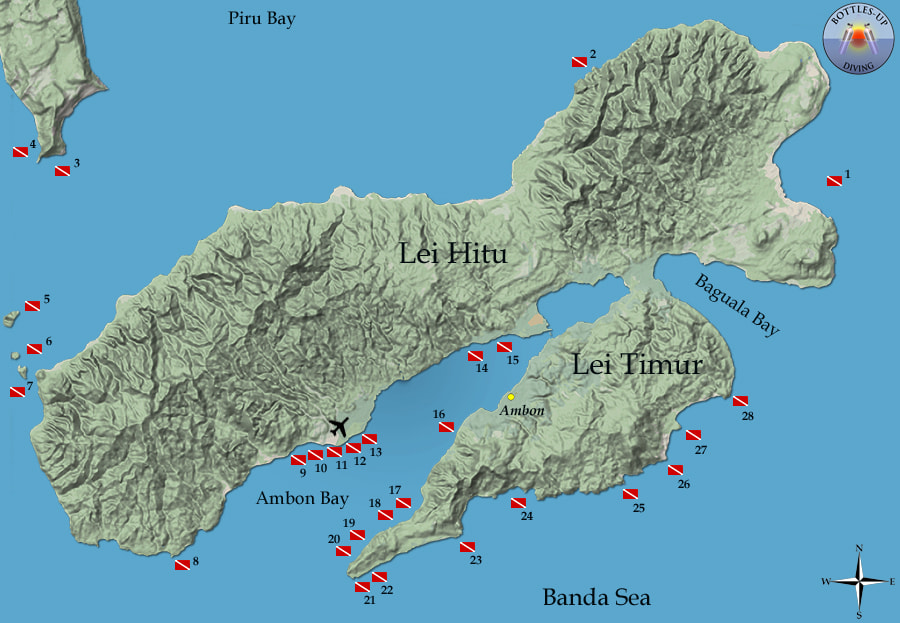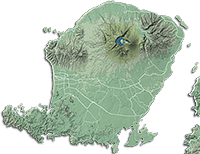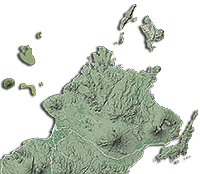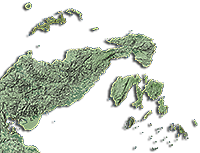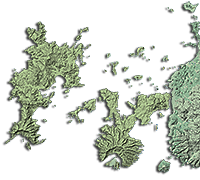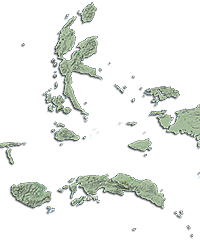Ambon - Moluccas or Maluku
Ambon became the Provincial capital for the Province of Maluku in 1999 when the Maluku province was divided in two Indonesian provinces: North Maluku (Maluku Utara) and Maluku, click here for more about Maluku.
The Maluku Islands
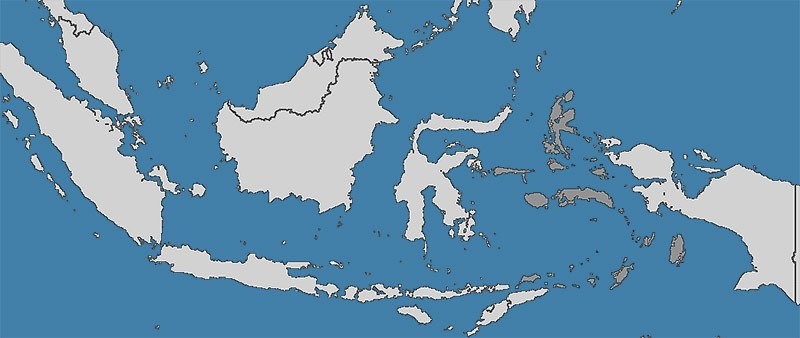
The Maluku Islands have a total area of 850.000 km², 90% of which is sea and there are an estimated 1027 islands. The largest two islands, Halmahera and Seram
are sparsely populated, while the most developed, Ambon and Ternate are small.
Geographicly they are lying between the islands of Sulawesi to the west and New Guinea to the east.
The Philippines, the Philippine Sea, and the Pacific Ocean are to the north; the Arafura Sea and the island of Timor are to the south.
North Maluku consists of the islands of Halmahera, Obi, Morotai, Bacan, and the main islands of the Sula archipelago (Taliabu, Mangole, and Sulabesi); significant smaller islands
include Ternate and Tidore.
North Maluku is predominantly Muslim and its capital is Sofifi on Halmahera island.
The population of North Maluku was 1.038.087 at the 2010 population count making it one of the least-populous provinces in Indonesia;
at the latest estimate (January 2014) the population had risen to 1.141.561.
185.000 people are living in Ternate only while 575.000 are settled on Halmahera Island (18.400 km²).
The more southerly Maluku Province consists of the islands of Ambon, Lease islands (Haruku, Saparua, Nusa Laut), Aru, Babar, Banda, Kei (Kai), Leti and Tanimbar, as well as Buru, Kisar,
Seram and Wetar.
Maluku province has a larger Christian population.
The province of Maluku had a population of 1.533.506 at the 2010 population count, and the latest estimate (for January 2014) is 1.708.190.
A bit of history of North Maluku
In the 16th and 17th century, the islands of North Maluku were the original "Spice Islands".
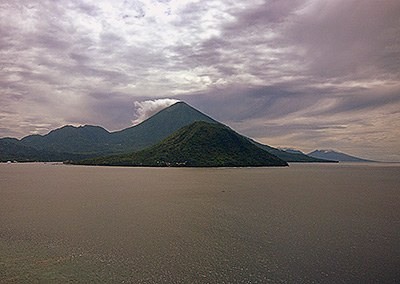
Known as the Land of Four Mountains,
or “Bumi Kie Raha” in the Ternatese language: Ternate, Tidore, Bacan and Jailolo, each of them are historic sultanates,
were once the seats of powerful empires whose territories stretched well beyond the boundaries of today's Maluku.
These empires built their wealth based almost entirely on the export of a single, but highly prized commodity - cloves.
Before the arrival of the first Europeans, merchants had already been sailing to these islands from as far away as Arabia to trade for clove, nutmeg and other exotic produce.
The Dutch, Portuguese, Spanish, and local sultanates including Ternate and Tidore fought each other for control of the lucrative trade in these spices. Clove trees have since been transported and replanted all around the world, and the demand for cloves from the original spice islands has ceased, greatly reducing North Maluku's international importance.
-
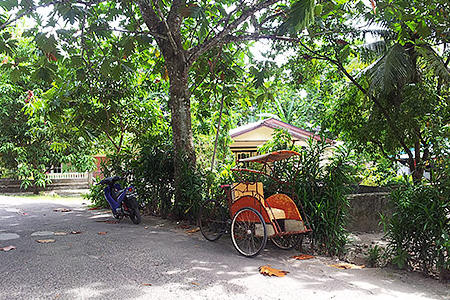
Parked becak near Silale - Lei Timur
-

Ambon city
-
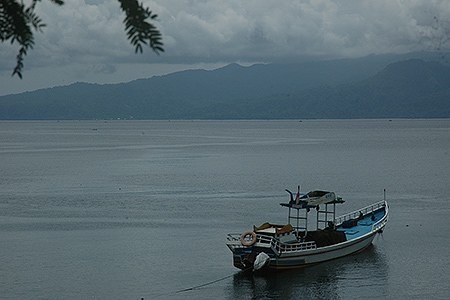
Ambon bay
-
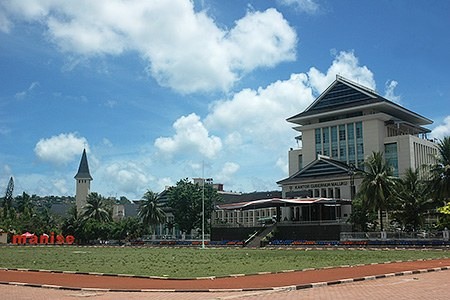
Governor building in the centre of Ambon city
-

View on the way to Latuhalat - Lei Timur
-
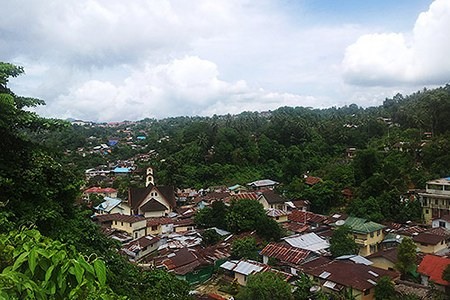
Village of Nusahiwe - Lei Timur
-
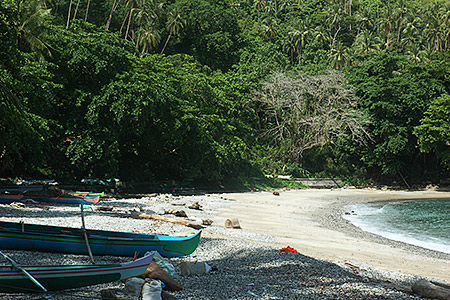
Beach near Silale - Lei Timur
-
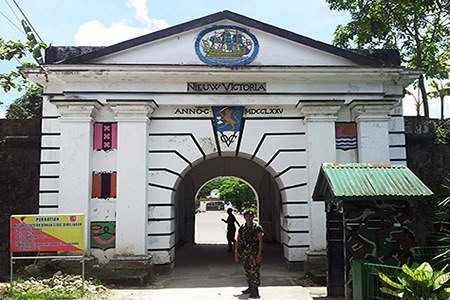
Fort Victoria, Ambon city
-
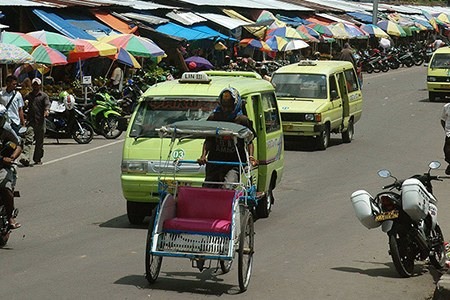
Colourfull market, Ambon city
-
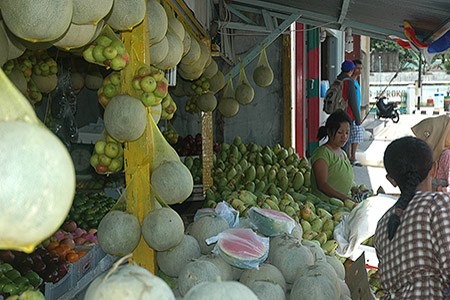
Fruit stall, Ambon city
-
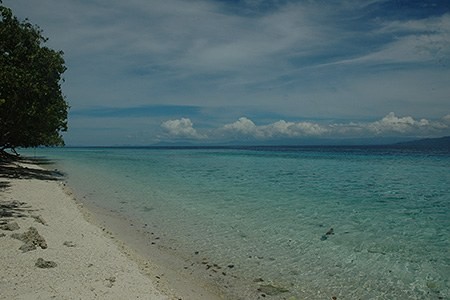
Liang beach - Lei Hitu
-
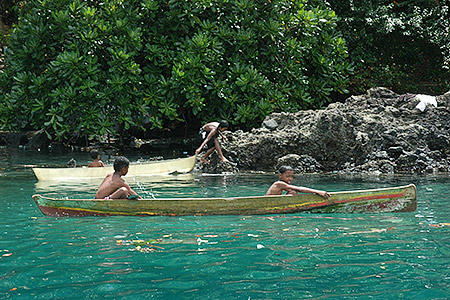
Local boys near Amahusu - Lei Timur
The island of Ambon is divided by Ambon Bay in 2 parts. The main part is called Lei Hitu and the peninsula, where Ambon city is located, is called Lei Timur. Lei Timur is predominantly Christian and Lei Hitu predominantly Muslim.
Between 1999 and 2002, Ambon was at the centre of sectarian conflict across the Maluku Islands.
The conflict had a significant effect upon the 2.1 million people of greater Maluku.
Leading up to the Malino agreement, Malino II Accord 13 February 2002,
the International Crisis Group estimated that 700,000 people had been displaced by
the four years of fighting in the Moluccas which is thought to have claimed a minimum of 5,000 lives.
Many websites still warn against visiting Ambon while Ambon has been as safe to visit as any other place in Indonesia for years now.
We have circumnavigated the whole of Lei Timur on a motorbike and we thoroughly enjoyed that. The roads, once out of Ambon city, are not busy and the scenery is beautiful. Everywhere
we came the people are friendly and always ready to have a little chat with you.
After our visit to the Banda islands we explored Lei Hitu, the rest of Ambon island. For this we made a couple of trips by car and visited historical sites, villages and some beautiful beaches.
Ambon is a very interesting destination with a lot of history and has therefore, next to diving, a lot to offer.
Geography of Ambon
Biogeographically, all of the islands apart from the Aru group lie in Wallacea, the region between the Sunda Shelf, part of the Asia block, and the Arafura Shelf , part of the Australian block. (click here for detailed map of Wallace Line).
The Wallace Line
The Wallace Line, or Wallace's Line, is a boundary that separates the eco zones of Asia and Australasia. The transitional zone is sometimes called Wallacea.
Plants and animals related to Asian species are found to the north-west; to the south-east are mainly Australasian species are found, with some Asian species.
The line is named after Alfred Russel Wallace, who noticed this clear dividing line during his travels through the East Indies in the 19th century.
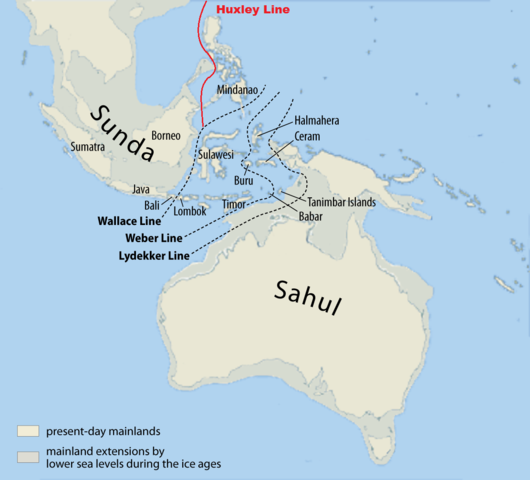 © "Map of Sunda and Sahul 2" by Altaileopard. Licensed under CC BY-SA 3.0 via Wikimedia Commons
© "Map of Sunda and Sahul 2" by Altaileopard. Licensed under CC BY-SA 3.0 via Wikimedia Commons
The probable extent of land at the time of the last glacial maximum (14.500 years ago) when the sea level was more than 110 m lower than today, is shown in grey. The deep water of the Lombok Strait between Bali and Lombok formed a water barrier even when lower sea levels linked the now-separated islands and land masses on either side.
Malukan biodiversity and its distribution are affected by various tectonic activities; most of the islands are geologically young, being from 1 million to 15 million years old, and have never been attached to the larger land masses. The Maluku islands differ from other areas in Indonesia; they contain some of the country's smallest islands, coral island reefs scattered through some of the deepest seas in the world, and there are no large islands like Java and Sumatra.
History of Ambon
Ambon was named Amboyna by the Dutch.
Ambon was colonized by Portugal in 1526 and originally named Nossa Senhora de Anunciada, founded by Portuguese-Moluccas governor Sancho de Vasconcelos.
The Portuguese were driven out by the Dutch in 1609. Except for brief periods of British rule, the island remained under Dutch control until Indonesia's independence in 1949.
(click here for more detailed history of the early period).
The struggle of the Ambonese people
Banda always has been famous for its Nutmeg, which originally only grew here. But fast it was transplanted to other parts of Maluku.
The major part of the 16th century - long battle for control over the spice trade was fought out on the Central Moluccan islands,
where this power struggle between European nations claimed many lives especially among civilians.
On Ambon alone, the ruins of more than forty fortresses testify to this relentless struggle for power.
The money that - according to a colonial adage - literally grew here on trees, soon brought discord and corruptness to the new rulers, who found it increasingly
difficult to counter the resistance that was flaring up on Ternate and the islands around Ambon. By the close of the 18th century, however,
coffee, tea and cocoa had succeeded in outranking spices in importance in world trade. The interest in the Spice Islands more or less died out, and the Moluccas went
into a kind of economic hibernation that lasted until the second world war.
From the hill in the suburb of Karang Panjang where the memorial to Martha Christina Tiahahu stands, one has a spectacular panoramic view of Ambon Bay and the illuminated city, which is especially striking at dusk.
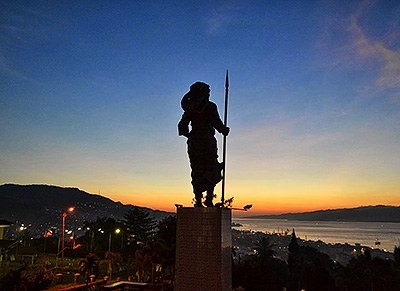
Martha Christina Tiahahu was a freedom fighter who fought alongside her father against the Dutch colonial regime and died, age 18 in 1818, while being transported to Java with a shipload of prisoners.
Another monument commemorated to the Moluccan people's struggle for freedom is that of Thomas Matulessy, also known as Captain Pattimura.
On March 5, 1817, he and his followers took Fort Duurstede on the little island of Saparua, east of Ambon.
They killed all the Dutch people in Fort Duurstede, except the 6 years old son of the Dutch resident.
The saving of this child gave Matulessy the name Pattimura which means "big of heart".
Betrayed by one of the local Rajahs, he was caught in an ambush on 11 November 1817 and taken prisoner.
He was hanged one month later. Before he died, he said to his Dutch executioners:
“I wish you all a pleasant stay”.
During the Dutch period, Ambon was the seat of the Dutch resident and military commander of the Maluku Islands. It was also the site of a major Dutch naval base, captured
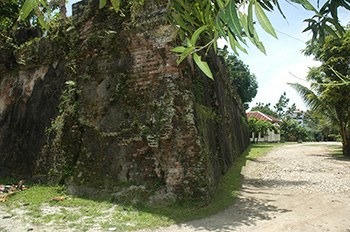 by the Japanese in 1942.
by the Japanese in 1942.
The town was protected by Fort Victoria, and a 1911 Encyclopedia characterized it as “a clean little town with wide streets, well planted”.
The population was divided into two classes, orang burger (citizens) and orang negri (villagers), the former being a class of native origin enjoying certain privileges conferred
on their ancestors by the old Dutch East India Company (VOC).There were also, besides the Dutch, some Arabs, Chinese and a few Portuguese settlers.
In 1950 Ambon was the center of an uprising against Indonesian rule, caused by the rebellion of Republic of the South Moluccas. Most of the people were loyal to the RMS movement. Indonesian troops invaded the city and reasserted control just in few months. Many important buildings such as the Victoria Fort (APRMS main base) were heavily damaged during the confrontation.
Dive conditions Ambon
Indonesia has two seasons: dry season influenced by the southeast monsoon winds, and the rainy or wet season, influenced by the northwest monsoon winds. In most of Indonesia the dry season falls between May and September and the rainy or wet season between October and April, but in the Moluccas it is reversed (click here for detailed weather graphs).
Ambon annual weather graphs




 © 2010-2015 World Weather and Climate Information
© 2010-2015 World Weather and Climate Information
Best time for diving in the Moluccas are the months March and April and from mid-September until late December.
Ambon offers two types of diving: Muck-diving mostly in Ambon bay and reef/wall diving around the island; best of both worlds.
Ambon bay has a depth of more then 500 metres, it is 23 kilometres long and at its "mouth" 8 kilometres wide.
(click here for detailed map of the water depths around Ambon).
Sea depths around Ambon
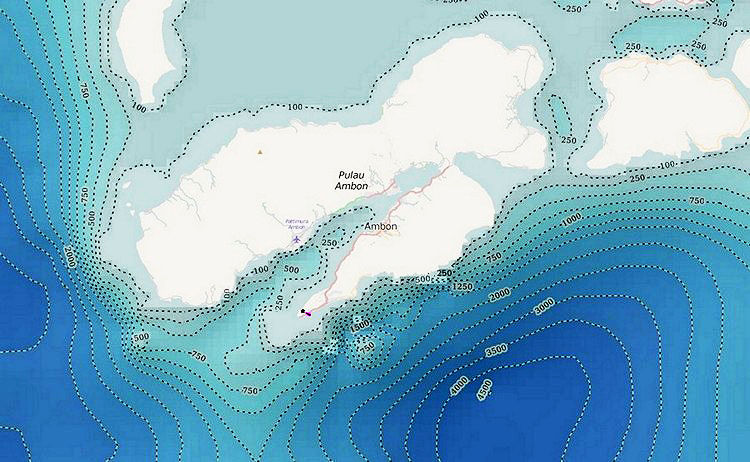 © www.openseamap.org
© www.openseamap.org
Muck diving
Muck diving usually takes place in brackish water, mangroves and harbours - environments that offer many possibilities for shelter. It gets its name from the sediment that lies at the bottom of many dive sites, frequently muddy or "mucky" environment, or may consist of dead coral skeletons, discarded fishing equipment, tires and other man-made garbage. Competition for food and habitat is less and the pressure from predators is lower than in a coral reef.
Animals in these environments have evolved incredible shapes, colours and behaviors. Ambon Bay has just the variety and quantity of debris to provide habitats for great muck diving and the water is unusually clear for muck diving.
It has an average visibility of 15 metres, but during full and new moon the currents in the bay
are quite strong and visibility decrease to a couple of metres.
Between full moon and new moon there is usually very little current and good visibility, 20 metres.
Underwater we can find some amazing critters, including the recently discovered species of frogfish - Psychedelic frogfish Histiophryne psychedelica -
but also Rhinopias, Mimic octopus, Zebra crabs and dozens of different nudibranch species.
A very popular find is the Ambon scorpionfish in differing colours of red, pink, green, yellow and orange.
Then there are the other members of the Scorpionfish family too, including the Spiny devilfish, Stonefish, Zebra lionfish, Ragged-finned lionfish and Leafy scorpionfish - all venomous but beautiful!
Wall diving
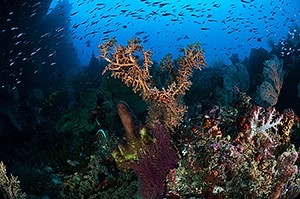
The reefs aren't heavily dived yet so they are in superb condition.
The highlight of diving the Southern side of Ambon are the underwater gardens.
Walls are covered with bright colours of both soft and hard coral colonies, large Sea fans and
Barrel sponges. There are many different types of Whip corals with Xeno crabs, Whip-coral shrimps and Gobies.
Big numbers of fish, but the bigger pelagic are not so often found here.
Blankets of Red-tooth trigger and schools of Fusiliers and Snappers scoured the reef with huge Napoleon wrasse, Bumphead parrotfish, and Groupers regularly spotted.
Shark numbers are decreasing at a shocking rate.... What all, especially divers, should know about the shark population.
Shark population
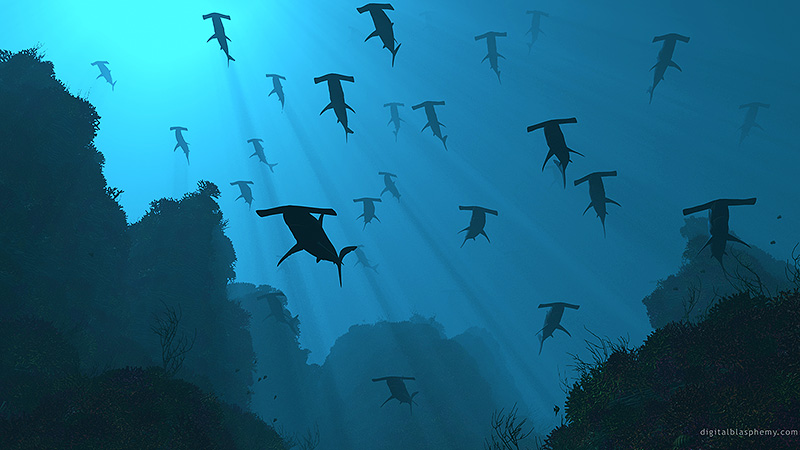
Most divers would love to see sharks, but should realize that there is a great slaughter amongst these apex predators happening every single day.
Indonesia ranks number 1 on the list of top 20 shark catchers.....
Diving in 1995 in the Bunaken national park we encountered sharks every dive. When we went back in 2008 we saw maybe 5 sharks on a total of 60+ dives!
When describing dive sites, we often mention that you might see sharks, but every year the chances are less..
An estimated 100 million sharks a year are killed, mostly for shark fin soup, says a shark researcher of the University of Windsor.
These are the shocking results done by the Institute for Environmental Research published in March 2013 in the journal Marine Policy.
The postdoctoral researcher, Steve Kessel, was part of this research team that came up with a more comprehensive estimate of the number of sharks being killed each year.
Due to the incomplete nature of the data for shark catches, that number could be as low as 63 million or as high as 273 million, but both the high and low end estimates are
considered outside of safe biological limits.
The study also found shark populations cannot reproduce fast enough to overcome that death rate.
There are about 400 species of sharks and 28% of them are threatened by extinction, Kessel said.
“One in every 15 sharks is taken every year”.
The Top 20 shark catchers in descending order are:
Indonesia, India, Spain, Taiwan, Argentina, Mexico, United States of America, Malaysia, Pakistan, Brazil, Japan, France, New Zealand,
Thailand, Portugal, Nigeria, Islamic Republic of Iran, Sri Lanka, Republic of Korea, Yemen.
Sources UNFAO, TRAFFIC 2013
Indonesia and India are responsible for over 20% of global catches between 2002 and 2011. Three EU Member States: Spain, France and Portugal, are among the top 20 shark catchers, responsible for 12% of global catches. Collectively, the 28 EU Member States are the largest shark catching entity of all.
Major hotels that continue to serve shark fin soup include:
Ritz Carlton-Hong Kong
Nikko hotels throughout Asia (headquartered in Japan)
Regal Hotels in Hong Kong
Prince Hotels and Resorts in Japan
InterContinental Group, a UK-based company
This list was comprised in conjunction with Wildlife risk.
Dive sites Ambon
When we came back from the Banda islands to Ambon we did all our dives in Ambon bay i.e. muck diving, since we had done so much wall diving around the Banda islands.
Here we describe most of the dive sites mentioned on the map including the ones we did not dive ourselves. This information is mostly from other divers whom we met
during our travels.
Dive site number 9 until number 18 are muck dive sites.
Batu Lompa - [1]
Famous for it's volcanic activity, bubbles rising up from the sea floor and between the rocks, the water around Batu Lompa is shallow with a maximum depth of 25 meter.
Visibility is very good in these clear waters and you can see all the way down to the bottom.
This site has strong currents and the water temperature is between 25 and 29°C.
Beautiful soft and hard corals covering around 40% of the total area.
Turtles have been spotted regularly here as well as Longfin bannerfish, Red-toothed triggerfish, Lionfish, Anthias, Fusiliers, Sweetlips, Butterfly and Cardinalfish.
Bigger stuff like Jacks and Barracudas and smaller like Scorpion leaf-fish are here as well.
Tanjung Setah - [2]
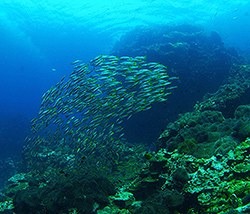
Literally Devil's cape is a beautiful dive site with a good variety of soft and hard corals.
Drop off with a maximum depth of 40 metres and a visibility of 15 metres.
Here you will see various kinds of coral reef fish like Bat, Angel, Trigger, Puffer, Butterflyfish and Groupers.
Schools of Jacks, Snappers, Fusiliers, and Barracudas are a treat. For the very lucky diver Turtles and Hammerhead sharks might show up, although this is very rare.
Tanjung Sial Timur - [3]
Tanjung Sial, Cape of Bad Luck is located on the southerly tip of Seram.
Many boats sunk or underwent problems here due to the strong currents hence the name.
This vertical wall does not have a lot of coral due to the currents but when it transforms into a slope coral growth picks up.
Maximum depth around 40 metres with good visibility.
Strong currents go hand in hand with a lot of fish and here you might encounter schools of Jack, Snapper, Fusilier and Barracuda.
Also Tuna, Bumphead parrotfish and Napoleon wrasse can be around.
Great site, but for the advanced divers since there can be down currents!
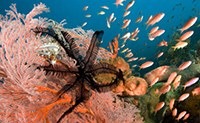
Tanjung Sial Barat - [4]
The west side of this cape, Barat means West and Timor means East, has more or less the same conditions as Tanjung Sial Timur.
Same fish can be encountered here like the schooling Snappers and Fusiliers.
This dive site is also for the more advanced divers, because of the strong currents.
Nusa Ela (pulau Tiga) - [5]
This is the only island of the three that has people living on the island. Diving around the three islands is simply amazing with the beautiful corals and marine life around.
Sloping reef with drop of at 24 metres and maximum depth 35 metres.
Visibility around the islands is around 15 metres, depending on the weather conditions.
Strong current so lots of fish around here: Surgeonfish, Fusiliers, Bannerfish, Long-nosed emperors, Trevally, Napoleon wrasse and a few Bumphead parrotfish.
Giant trevallies, Groupers and Black-tip reef sharks have also been sighted here.
Nusa Hatala (Pulau Tiga) - [6]
A small rock island with a beautiful white sandy beach, good place for lunch after the dive. The island is surrounded by crystal clear water and has gorgeous coral reefs and underwater life.
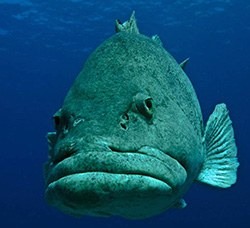
Maximum depth is 40 metres and great visibility of 20 metres.
Schools of Red-toothed triggerfish swarm the waters, together with groups of Eagle rays and Black-tip reef sharks.
Also great for snorkeling.
Nusa Lain (Pulau Tiga) - [7]
Again a beautiful island with an amazing underwater world.
Sloping reef and walls with average depth of 25 and maximum depth of 40 metres. Visibility depends on weather condition, but can be up to 20 metres.
Currents can be strong, but offer a lot of fish like Jacks, Snappers, Fusiliers and Barracudas.
For the lucky ones there is the Giant Potato grouper, Tuna and the Black-tip reef shark.
Tanjung Alang - [8]
This dive site has a beautiful mix of soft and hard corals unlike the other dive sites who are manly covered in algae and soft corals. After a couple of muck dives this is a nice change of scenery in Ambon Bay.
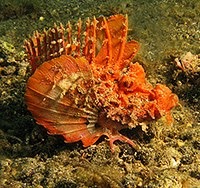
Batu Berdiri - [9]
This is the start of the critter dive sites on the northern shores of Ambon Bay.
The underwater topography of the dive sites is a change of sandy areas, rubble covered slopes and valleys in between with some coral outcrops.
Here you can find everything you find in Lembeh with the advantage of the lack of divers and with 20 metres visibility....
Most members of the Scorpionfish-Family can be found in Ambon, noticeable are the many Devilfish variations, Inimicus didactylus, on sandy patches.
Airport Jetty - [10]
Past the end of the airports runway is the pier which offers a shelter for many juvenile fishes.
The columns are covered in sponges and are a sight on their own. Best light, so best time to dive, is between 11am and 2pm.
Large schools of small fishes and juvenile Batfish between the columns and on the sand you find small critters like Nudibranchs, Eels,
Lionfishes and sometimes Rhinopias scorpionfishes.
Air Manis - [11]
This dive site is in the area of a working pier so there can be boats overhead. There is rubbish around, but also plenty of interesting critters.
There is so much to see on this between the rubbish, patches of soft coral and rocks.
This site offers a good mix as it has a variety of critters as well as massive schools of fish circling under the pier.
Just to name a few species that are around here: Frogfish, Flamboyant cuttlefish, Eels, Pipefish, Ghost pipe-fish, Batfish, Nudibranch and Crionoid crabs.
Rhino City / Twighlight - [12]
The whole area from Rhino City through the Twilight Zone to Laha is a great place for diving. The dive sites are basically slopes with stones, patches of corals, sponges and soft corals. It seems to be one of the places you regularly find Rhinopias scorpionfish.
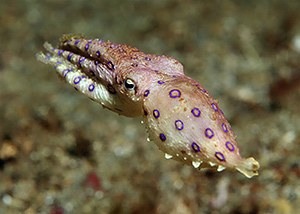
Although when we were diving here they all seem to have moved to the other site of the bay where we spotted a couple of them. We encountered a variety of other Scorpionfish, Seahorses, Octupus, Cuttlefish and many special Crabs. At dusk watch out for the dancing beauties performing their mating dances...Mandarin fish.
Laha - [13]
The site is the general area around the jetty at the village of Laha, on the northwest side of the harbour close to Ambon's airport.
A small sheltered bay with a sloping sandy shoreline that offers protection for both the ships at anchor and the inhabitants beneath the surface.
The slope levels off a little at 12 metres before continuing down again into Ambon Bay's murky depths.
Nearby jetty you can find many Moray eel species, several species of Lionfish and Stonefish, including the Spiny and Spotted devilfish.
Lots of small Crustaceans, Octopus, Cuttlefish and much more. Laha is a great critter site.
Mimic point - [14]
This dive site has a fine sandy sloping bottom which is pretty much barren until you start looking closely. Famous for the Mimic octopus, which was not around while we were diving here, but we did see Cuttlefish, Ambon scorpionfish, Seahorses, Ornate-ghost pipefish and more.
Wreck SS Aquila / Duke of Sparta - [15]
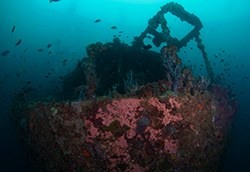
The wreck-site of the SS Aquila is marked by a large rusty buoy attached to the stern, which is in just 12 metres of water.
SS Aquala is 134 meters in length and 17 meters wide measured by Marcel Hagendijk who conducted a series of penetration dives inside the shipwreck.
He also established that the ship was bombed in Ambon harbour during Operation Haik -
a clandestine Cold War CIA operation against Indonesian communist rebels in 1958.
The initial bombing did significant damage to the SS Aquilo, but not enough to sink her and it was another month before she finally went down on the 27th May.
The wreck is located at the busy part of Ambon's harbour which results in a not so good visibility.
The visibility varies between 5 to 15 metres and the best time for diving is during incoming tide.
SS Aquila lies facing down the slope of the harbour with its foredeck at 32 metres and the bow at 40+ metres.
The wreck is covered in deep pink and purple soft corals and is irresistible for the profuse amount of fish in the area.
Lots of fish around and of course a multitude of cleaning stations with Wrasse's and Shrimps for the local inhabitants.
Amahusa - [16]
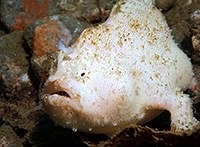
Less sites on the east side of the bay, but both the west and the east side are all located on the fairly steep slopes of the bay.
It starts with a sandy slope leading to a nice patchy reef with a lot to see like Leaf scorpionfish, Hinche-beak shrimps, many Nudibranchs and more.
Anemonefish, Clown frogfish and take a look at all the Whipcorals for Shrimps and among the other Coral fans for tiny Crabs and the Decorator spidercrabs.
Back in the shallows there is healthy Coral and a lot of Featherstars and Jawfish around.
This is a site you can dive more than once...
Blue Jetty - [17]
The area is covered with sand with some sponges, corals, some garbage and a lot of critters.
Here we spotted the tiny white Clown frogfish in a car tyre on the sandy part. Also a couple of small Cuttlefish and a Coconut, also known as Veined, octopus using a green bottle as her house.
The columns are covered in sponges and are a real sight with juvenile Yellow-spotted boxfihes, Valentinni's sharpnose puffers lots of tiny Crabs and Shrimps.
There are Batfish, schools of different small fishes and often Frogfish can be seen on the columns.
At the end of the dive we came eye to eye with a beautiful Blue-ringed octopus....after 5 minutes observing this little creature we decided to signal the other divers.
Pantai Paregi - [18]
This dive starts about 100 metres south of the jetty with a steep slope covered with nice corals and large sponges and with some sand coming down in channels. The slope turns in a wall with nice small crevices, lots of Turnicates and large Coral outcropping's. Damselfish, Angelfish, Trumpetfish, Starfish, Black triggerfish and a huge Moray eel between the corals.
Pantai Nama Wall - [19]
This is a very nice wall covered in lots of corals and large Sponges. While looking closely to the reef do not forget
to turn around and look in the blue.
There were several large Groupers, a Hawksbill turtle and also a Sea snake around.
One area is completely covered with Black coral bushes with a lot of small Damselfish and Longnose hawkfish.
Then at another point there is a large outcropping with a bit of current and lots of Butterflyfish.
In between there are lots of Shrimps, Nudibranchs and Orangutan crabs in the Bubble corals to be seen.
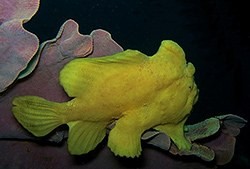
Pantai Nama Slope - [20]
Close to Pantai Nama Wall is this site where the wall becomes a slope with less coral and more rubble. Not as nice as the wall but a good place for Frogfish, Ornate Ghost pipefish, Sea cucumbers with Emperor shrimps on top and lots of other critters.
While looking for something small we nearly oversaw a big Giant or Commerson frogfish minding its own business on a leaf of a soft Coral.
Depan Tupa - [21]
Southern side of Ambon are the dive sites are manly walls with both soft and hard coral colonies, large Fans and Barrel sponges.
Depan Tupa has not so much corals due to the current that can be strong around here.
Visibility is around 20 metres with an average water temperature of 28C, like most of the dive sites on the southern side of Ambon.
Schooling fish like Jack, Snapper, Fusiliers and Barracuda passing by together with the, for Indonesia, normal diversity of reef fish.
To name some of them: Butterfly, Angel, Anthias, Parrot, Trigger, Puffer and Porcupine fish.
Namalatu - [22]
This is a wall dive on a nice Coral reef with lots of sea Fans and Gorgonians.
Visibility is good, around 20 metres, with a maximum depth of 25 metres.
Also here you will find schools of Jack's, Snappers, Fusiliers, Trevallies around.
Sometimes you can see a Sea snake and of course keep a look out for the Moray eels, who can be quit big around here.
This is a good site for a night dive.
Pintu Kota - [23]
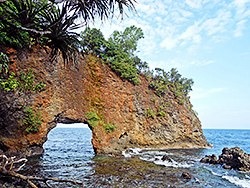
Pintu Kota, or City Gate, one of the famous sites on the south coast, gets its name from the several large arches
that creates the impression of large gates.
Visibility can be an amazing 30+ metres on this site and there can be strong currents at the surface, but this will grow less while going deeper.
Underwater there is a very large archway at 17 metres that mirrors the ones above water and the healthy surrounding reef and clear blue water.
There are strong currents on the other site of the arch so big fish, even Manta rays, can be around here sometimes.
Napoleon wrasse's are seen on this site many times.
Tanjung Mahia - [24]
Mahai has a nice wall and sloping down to 37 metres with a cave at 30 metres.
Abundant coral growth is found here, including beautiful coloured Tubastreas and big Fans at 24 metres.
Schooling of Jack, Snapper, Fusilier and Barracuda and sometimes Manta ray, Tuna and, if you are very lucky, even Hammerhead sharks can be seen here.
In the shallows the bottom is carpeted with golden-hued Hydroids. You can see the waves above you
crashing along the rocky shoreline, while sunbeams added a magical touch.
Tanjung Kilang - [25]
This is a sloping reef with a maximum depth of 35 metres and some currents so visibility a bit less than the other sites here, around 15 metres. The Corals are in a good condition and schools of Jacks, Snappers, Fusiliers and Barracudas can be seen here. There is a nice underwater cavern to be explored.
Tanjung Hukurila - [26]
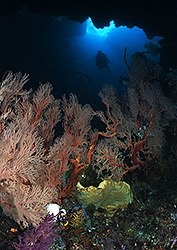
Hukurila Cave is further east along the coast from Pintu Kota. The interesting twisting chimney can be best entered from the top. It is the most famous and liked dive site on the south side and is located underneath two rock arches. These natural formations can be seen from the surface and lead to a swim-through covered in sponges and soft corals.
The visiblity can be up to 28 metres here which makes the scenery even more spectacular.
This site is quite an unusual dive, offering the thrill of making your way through twisting passages, caverns and canyons. The Barrel sponges, huge Sea fans and plenty of Table corals indicate little or none disturbance from human activities.
Hukurila Cave is literally swarming with life.
Lehari - [27]
More north from Hukurila cave is this site located. It has a sloping reef that drops down to 40 metres.
Visibility is normally around 20 metres with moderate currents, that can be strong depending on the moon phase.
During this drift dive you see beautiful coral with schools of Jacks, Snappers, Cardinal and Angelfish. and even Bumphead parrotfish are around this site.
Always great to see a huge school of Barracuda's passing by....
Batu Kapal - [28]
The name Batu Kapal means Ship Rock.
There can be strong currents around here so keep your eyes open for the bigger pelagic in the blue.
The wall has patches of soft and hard coral and has a maximum depth of 32 metres.
All different fish to be found around here; small colourfull Anthias, Gobies, Blennies and the bigger Moray eels and Groupers.
Look out for Rays and schools of Barracuda's and Sweetlips.
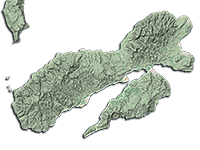
Other locations
Other dive locations which can be reached easily from Bali or direct from your home country...

